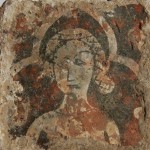Archaeology

Prehistoric & Neolithic periods
No evidence of Mesolithic or Neolithic activity has been found at the church site although there is evidence of Mesolithic and Neolithic activity in the area. Finds of flintwork and pottery from this era have been discovered on Castle Hill and the East Hill.
The Ridge is an important ridgeway route that may have originated in prehistory
Bronze Age
Bronze Age flintwork and pottery has been found on East Hill and Castle Hill. A single Bronze Age burial mound (Barrow) was recorded as existing at the south-west corner of East Hill but has subsequently slipped over the cliff edge.
Iron Age
An Iron Age promontory hillfort is located on East Hill, although both this and the enclosure on Castle Hill are currently undated.
Roman period
A possible Roman road (Rochester to Hastings Roman Road) follows the ridgeway route along The Ridge.
There have been numerous discoveries of Roman coins, including one found at Sandrock Hall. Nearby at Elphinstone Road there was a much more substantial find in May 1989 of 92 bronze and 59 silver coins, the latest dating from the reign of the emperor Hadrian AD119 -125.
These together with Roman pottery found nearby would seem to confirm that there may have been a settlement, trading centre, and perhaps a port located nearby.
Saxon Hastings
There is virtually no archaeological evidence for Saxon activity at Hastings, although King Offa conquered the Hastingas in 771, and Hastingecentre appears in the Burghal Hidage in the 10th century, assessed at 500 hides.
One suggestion is that Offa may have founded a church at Ore and had it dedicated to St Helen, his favourite saint. There is no mention of Ore in the Domesday Book.
Norman- modern periods
From the post Norman period we have the architectural and written evidence for both the manor and the church.
